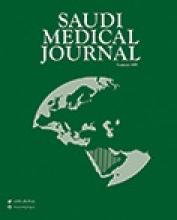Abstract
OBJECTIVE: To determine the clinicopathologic patterns of prostatic diseases in Saudi patients, with special emphasis on prostate cancer (PCa).
METHODS: The records of patients who underwent histopathological examinations of their prostatic specimens in King Abdulaziz University Medical City and King Faisal Specialist Hospital, Jeddah, Kingdom of Saudi Arabia, between June 2003 and June 2008 were reviewed retrospectively. The age, indications for biopsy, histological diagnosis, and Gleason grading of cancer patients, were studied.
RESULTS: The study included 330 patients aged 37-100 years (median=68). Specimens included 233 transrectal ultrasound (TRUS) biopsies, 85 transurethral resection of the prostate (TURP), 8 simple prostatectomies, 3 radical prostatectomies, and one radical cystoprostatectomy. Indications for TRUS guided biopsy in PCa patients were elevated prostate specific antigen (PSA) (85.2%), abnormal digital rectal examination (5.5%) or both (9.3%). Prostate specific antigen values <4 ng/ml were found in 13.6% of PCa patients. Among others, adenocarcinoma was found in 28.5%, benign prostatic hyperplasia (BPH) alone in 43.3%, BPH with inflammation in 20.3% and inflammation alone in 4.2%. In specimens of TURP or simple prostatectomy for apparently benign disease, incidental PCa was detected in 14/93 (15%). The Gleason sum of ≥6 was found in 92.8% of patients.
CONCLUSION: The incidence of prostate cancer in Saudi Arabia is low compared to the western countries. However, incidental PCa detected in presumed benign disease appears to be rising. Further future studies addressing this issue are needed to confirm the potential rising trend, and its possible etiology. Our findings support the recommendations to lower the PSA cutoff value for prostatic biopsy to 2.5 rather than 4ng/ml.
- Copyright: © Saudi Medical Journal
This is an open-access article distributed under the terms of the Creative Commons Attribution-Noncommercial-Share Alike 3.0 Unported, which permits unrestricted use, distribution, and reproduction in any medium, provided the original work is properly cited.






